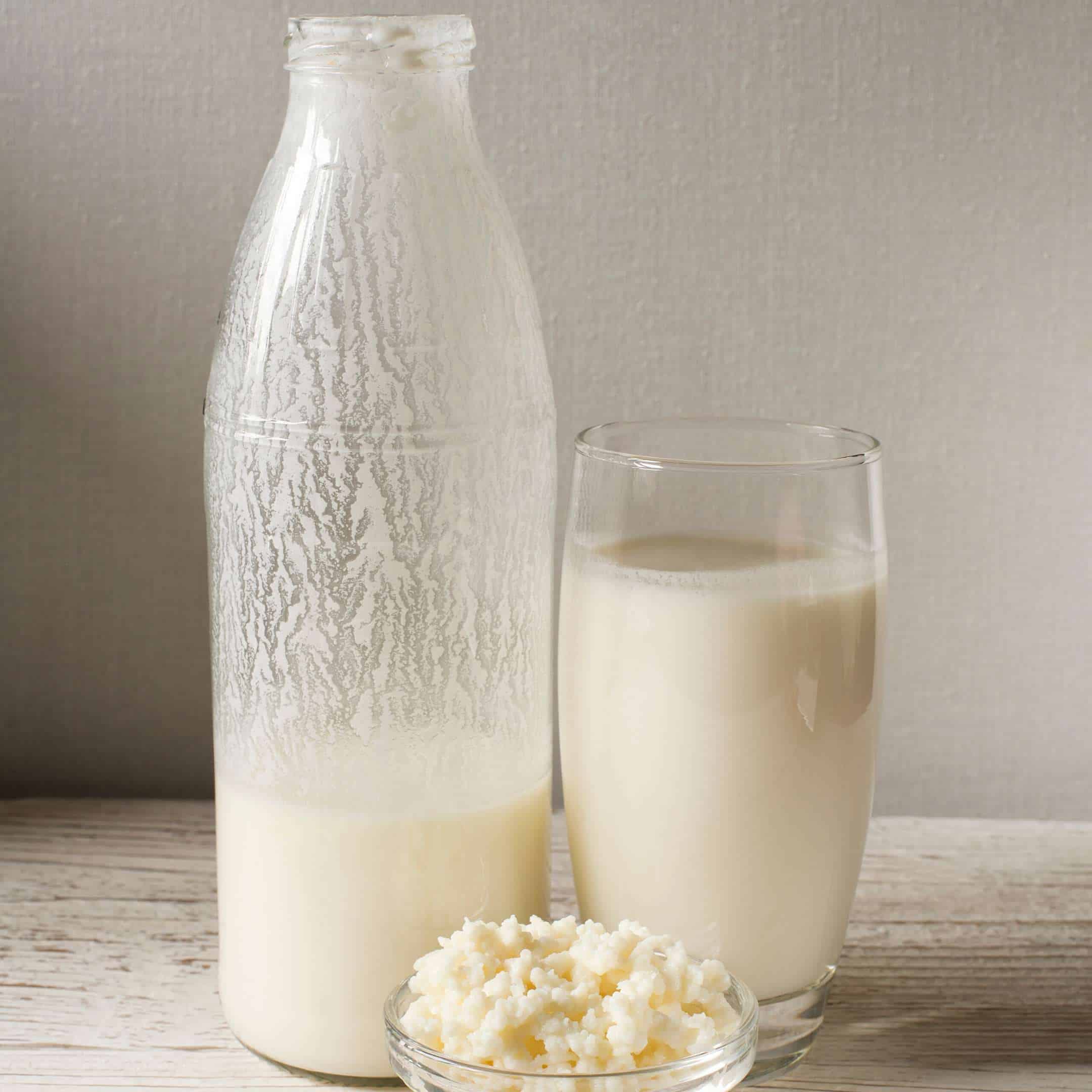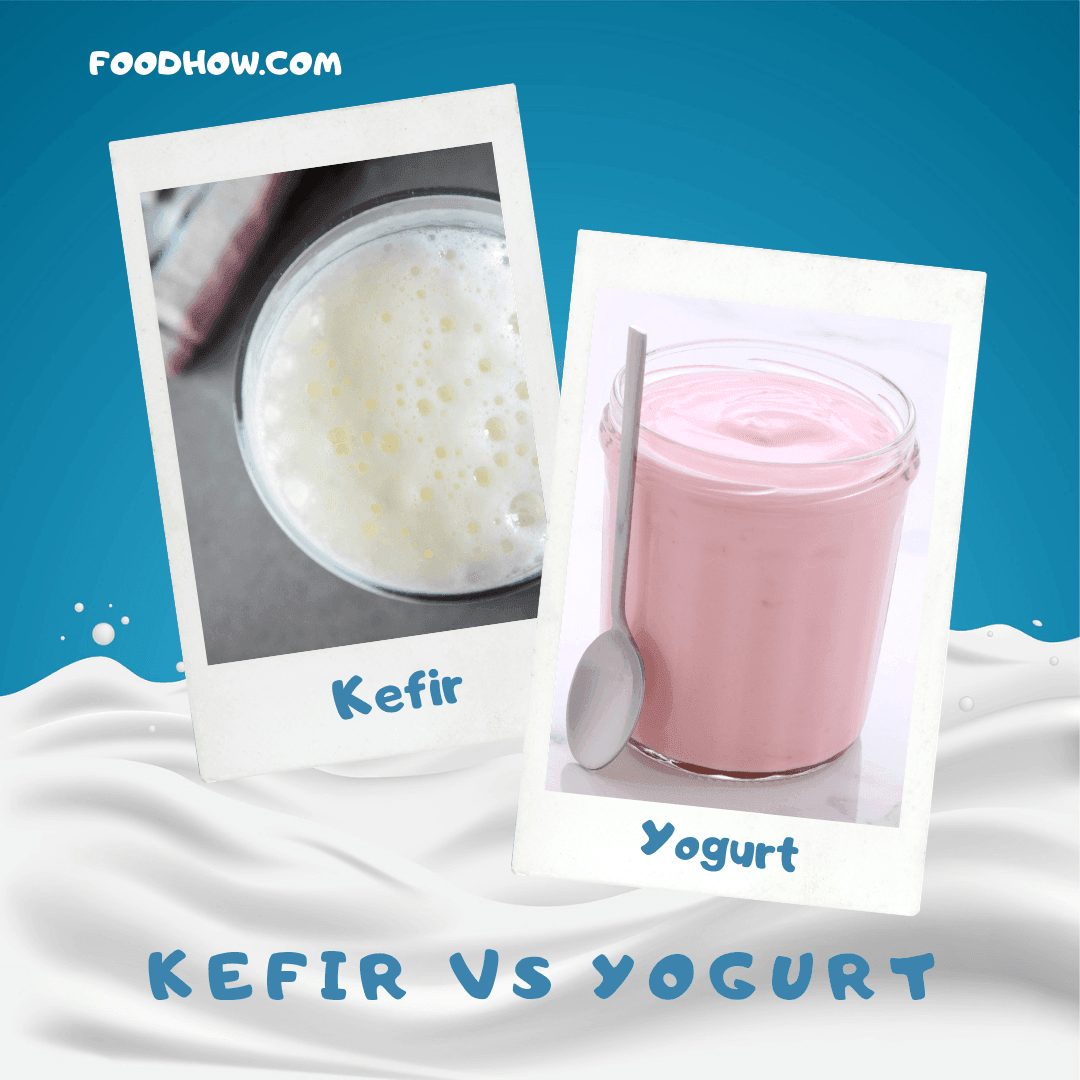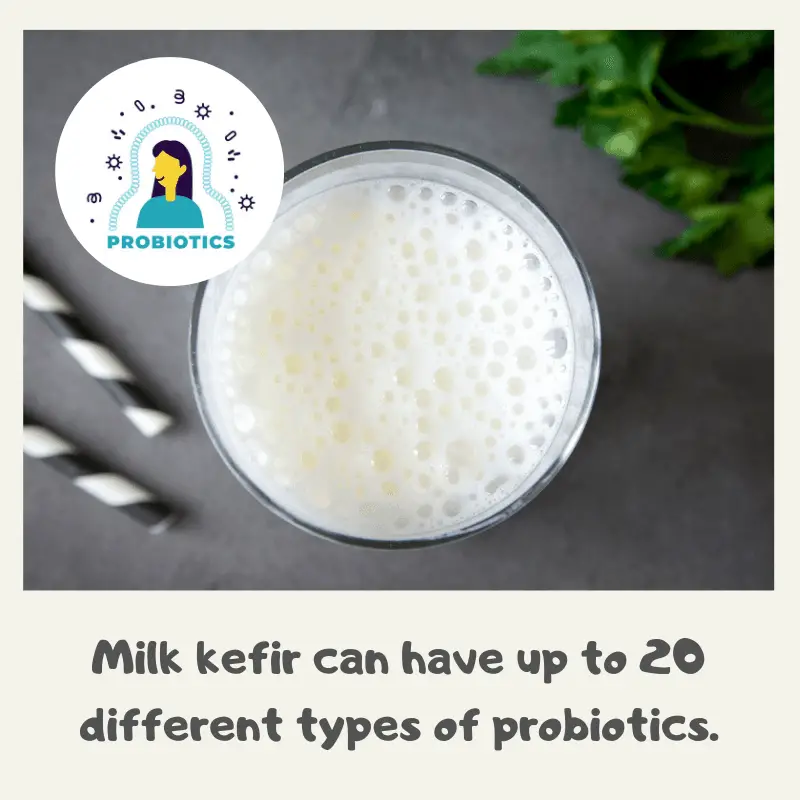Many enjoy dairy products for their rich flavors and multiple health benefits. This proves especially true for fermented products such as yogurt, which can aid in digestive and overall well-being.
Unfortunately, however, some sugars found in most dairy products can be highly upsetting to digestive systems—forcing them to look for alternative options.
If you are in this boat, you have likely heard of kefir. Though certainly not a new product, it has only just started to build an international reputation in the West.

But what is it about this fermented dairy product that has got many so excited?
I can tell you from my own experience that this wonderful product can have several benefits for your body.
If you are struggling with lactose intolerance or other digestive issues, kefir may be able to help.
Below, let’s take a detailed look at this fermented beverage, see how it compares to yogurt and soured milk, and see which one is best for keeping your gut under control.
Where Does Kefir Come From?
Let’s start with the basics: where does kefir come from?

This fermented dairy product has its roots in Eastern Europe and was first mentioned in Russia in 1867. Despite being popular, however, it didn’t find a foothold in the West until the early 21st century.
Even now, kefir enjoys a more specialized market, with many consumers unaware of its amazing benefits. In fact, unless you are looking for a dairy alternative, kefir likely isn’t something you’ll encounter.
That being said, consumers would do well to start adding kefir to their shopping carts. Made from starter grains, kefir includes many necessary proteins and biotics that are great for your gut health. Not to mention, it has a great distinctive taste that you are sure to love, as well.
Kefir vs. Yogurt

Many think of kefir as a form of yogurt, but the two actually have a number of important differences. Still, those who enjoy yogurt or need a yogurt alternative may find kefir a pleasing option.
Let’s examine the differences between these two fermented products more in-depth.
1. Texture
First and foremost, you will notice that the two have a much different texture. While yogurt tends to have a thicker, richer consistency, kefir comes in more of a liquid form. For this reason, people tend to drink it, as opposed to eating it like yogurt.
Kefir also has bubbles, giving it an almost carbonated appearance.
2. Benefits
Yogurt enjoys a pretty solid reputation for those looking to improve their gut flora. Because many yogurts contain probiotics and other enzymes, they have become a popular option for those suffering from digestive disorders.
However, you may be surprised to learn that kefir reigns supreme when it comes to gut health.
That’s right—this fermented beverage can contain up to three times more gut-friendly probiotics than yogurt. What’s more, these probiotics include a diverse range, helping resolve a greater number of issues.
For this reason, kefir should be at the top of your shopping list if you value your gut health. By drinking kefir, you can start to notice a balance in your digestive flora rather quickly.
3. Ingredients
While both kefir and yogurt can be made from dairy (as well as alternatives), differences in ingredients do exist. Perhaps the most obvious difference is that kefir contains yeast, and yogurt does not.
These yeasts help improve kefir’s overall ability to support one’s health. As you can see, this proves to be another advantage over yogurt for health-conscious individuals.
4. Taste
If you are like most people, however, taste comes first. After all, who wants to eat or drink something that doesn’t taste good—even if it is great for your health?
With this in mind, let’s take a look at how kefir stacks up in taste. Does its healthy makeup keep it from having a great taste that you can enjoy?
Fortunately, no. Though it does have amazing benefits, it doesn’t have the bitter taste of medicine. Instead, many are shocked to learn that it has a taste pretty similar to yogurt: sour.
But of course, this slightly sour taste depends on the brand of kefir you get. Just like yogurt, flavored varieties exist, so you will have plenty of options to choose from. This means that even if you don’t like sour foods, you should be able to find a kefir flavor that suits you.
That being said, let’s take a look at how kefir stacks up to some other popular probiotic dairy products like soured milk.
Difference Between Kefir And Soured Milk
As noted, kefir typically has a sour taste similar to that of yogurt. Does that mean, then, that it is similar to soured milk?
The difference between kefir and sour milk proves quite particular. Unlike yogurt, where there are major differences between the two products, the case isn’t so clear.
In fact, kefir and sour milk differ in only one production method. For this reason, many believe that the two are the same. This, however, is incorrect.
To better understand the issue, consider how the two are made.
Both use raw milk—milk that hasn’t been pasteurized. This keeps the natural probiotics in the milk, giving it the ability to ferment. Milk that has been pasteurized cannot be used, for it doesn’t have natural probiotics. For this reason, pasteurized milk will not ferment; it will spoil.
Making both sour milk and kefir is easy. To make sour milk, one simply needs to let raw milk sit and ferment.
With kefir, however, you will need to take one more step. To make kefir, simply add kefir grains to raw milk and then ferment.
As you can see, the two aren’t incredibly different. However, the addition of kefir grains does work to make kefir a more nutritional product. Though both will contain probiotics, kefir will have more beneficial bacteria and a higher concentration of them.
For this reason, consider replacing your soured milk with kefir. In doing so, you can trade one Eastern European drink for another—all while enjoying a number of health benefits.
Benefits Of Kefir

You may have noticed that I always talk about the health benefits that you can get from kefir. But what are these health benefits, exactly?
Let’s take a look.
1. Clean and Balance the Digestive Tract
Kefir contains an incredible number of probiotics. These substances work to kill harmful bacteria that may be living in your gut.
This has a number of benefits. For starters, kefir will work to restore your body’s natural balance. With the right number of probiotics, you’ll have fewer issues with digestion. This leads to overall feelings of improved health.
Additionally, by regularly drinking kefir, you can reduce the severity, duration, and likelihood of diarrhea.
2. Improve Immune Health
But that’s not all kefir’s probiotic nature can do. This great beverage can also work to increase your overall immune health. By killing harmful bacteria in your gut, kefir strengthens overall immune health.
What’s more, kefir has become known for its antioxidant properties. These properties allow it to aid the body in combatting a number of diseases and conditions.
In this way, regularly consuming kefir can improve one’s overall health.
3. Detoxify the Body
Finally, with improved gut health, your body will have a chance to detoxify. With your gut’s natural balance restored, you’ll feel cleaner and healthier.
Kefir also helps those with diabetes by preventing excess amounts of sugar from reaching the bloodstream. This can prevent dangerously high sugar levels and work as a natural sugar reducer.
This sugar-fighting ability comes from kefir grains. These grains include powerful lactose-eating bacteria that help make it safer for diabetics.
What Are Kefir Grains?
What, then, are kefir grains? You’ve likely noticed that I’ve mentioned these important grains a number of times throughout the text.
But what are they? Where do they come from? And what makes them so powerful?
Let’s take a look.

Kefir grains are living microorganisms that occur in nature. These grains consist primarily of yeast, bacteria, enzymes and look a bit like cauliflower, and feel gummy to the touch. Live kefir grains are 100% natural. This means that you can be sure of their quality and benefits.
If you are looking to find kefir grains, you can do so online or in specialized grocery stores and markets.
You may also find that some people in your area are into making kefir. If so, you may get some insider tips and tricks on how to maximize your kefir’s flavor and benefits.
With this in mind, let’s take a look at some more information that you should know!
Is Kefir Lactose-Free?
One of the most common reasons that people move away from milk and other dairy products is lactose. This sugar is found in a variety of dairy products, including yogurt, and can cause severe digestive distress.
For those suffering from lactose intolerance, this sugar poses serious problems. If you suffer from lactose intolerance, it is important to know just how kefir will affect you. If you are easily affected by lactose, keep the following information in mind.
For starters, let’s look at the easy question. Does kefir have lactose? As you may have guessed, because it is made from milk, the answer is yes.
Though this may sound off-putting, I have good news for you. Unlike other dairy products, the lactose in kefir doesn’t cause digestive issues.
Why?
Because compounds within kefir work to neutralize the lactose sugars to make it safe for you to drink. In other words, the lactose-eating compounds in your kefir grains work to reduce the lactose found in your milk. This means that you don’t have to worry about having an upset stomach because of your kefir!
Can You Make Kefir With Lactose-Free Milk?
I get what some of you may be thinking: “I’ve heard this before.” How many times have you been promised that something wouldn’t upset your stomach only to find out that it did?
If this has happened to you, you may be taking extra precautions about what you put in your body. In this way, you may even be thinking that making kefir is impossible—unless, of course, you could use lactose-free milk.
But will lactose-free milk work when making kefir?
You may be better off trying other methods. Instead of using lactose-free milk, for instance, consider fermenting longer.
As your kefir ferments, the lactose-eating compounds in the grains will lower the lactose count.
This method proves so effective that your kefir can be 99% lactose-free. You can be all but sure that it will have a negligible effect on your body at these levels.
What’s more, because you’ve fermented your kefir longer, you can expect a stronger taste.
Is Kefir Probiotic Or Prebiotic?
You may have already guessed the answer to this question.

Kefir puts strong, natural probiotics into your digestive system. Much has been said of probiotics’ ability to help aid in digestion, but kefir offers an even better deal.
Unlike other probiotics—such as those found in yogurts—the probiotics in kefir stick around. This means that they don’t just pass nutritional content to existing bacteria in your gut. Instead, they stay behind and help restore balance long-term.
How To Make Kefir At Home?
It is fast and simple to make Kefir. Just keep reading this guide to find out how.
Here is what you need to get started:
Reusable Milk Kefir Grains Cultures
- Reusable
- Gluten-free
- Organic
- Easy to use (as seen in the video below)
- FREE Access to the 155-page e-book
Kefir Fermenter With Enlarged Class Jar
This fermenter jar makes making kefir so much easier with no mess and no spatula or strainer needed. It consists of a straw, lid, jar, and plastic chamber for the grains. Live kefir grains have contact with milk through many holes making the fermentation process fast and easy. Grains are safely separated from ready-to-drink kefir.
Instructions
- Start with 1 tsp. of milk kefir grains.
- Put the grains inside of a jar.
- Pour 250ml of milk into the jar.
- Cover the jar with a lid (or cloth that is secured with a rubber band).
- For up to 48 hours, leave the jar alone in a room with shade and no direct sunlight.
- Use a fine-mesh, non-metal strainer to strain the kefir.
- Get another jar and pour the grains into it. Cover the grains with milk.
- Repeat the process
Fermented milk will start to separate after a certain amount of time. Don’t worry because this is normal. Kefir whey is the clear liquid that you see.
To restore drinking steadiness, stir the solution with a non-metal tool. Now pour the solution through the sieve. If the curds are thick, keep pouring a couple of times until you get it all.
What are the signs that it’s ready?
The liquid should be very thick, having more thickness than milk has. It should also be separate as well. The odor may resemble a sour smell; it’ll be quite cheesy and somewhat yeasty.
In this video below, you will learn how to make milk kefir at home, and it would be only a fraction of the cost of buying ready-made ones at the grocery store. As you will see, it is one of the easiest cultured foods to make!
What Milk Is Best For Making Kefir?
You can use almost any type of milk to create milk kefir. But there are some exceptions to this. Your grains will need time to adjust if you start using a different type of milk than what you were using before. One type you should not use is UHT milk.
1. Fat Content – 100% Fat-Based Milk Is Always The Best For Grains
Full fat milk ferments more easily, and its texture is much better too. Now, this doesn’t mean low-fat milk is bad to use. Some people prefer low-fat milk for health reasons. Just realize that your grains will reproduce and ferment slowly in low-fat milk.
Also, when you go to eat the final product, it won’t taste as good. The thickness won’t even be that great either. Remember that fattier milk causes kefir to get thicker.
2. Pasteurized Milk vs. Raw Milk
It is best to use the same type of milk to grow your grains that they were grown in previously. If you wish to switch milk, then at least wait a couple of weeks first before switching.
For instance, if pasteurized milk was used before and you’re looking to switch to raw milk, continue using the pasteurized milk for at least 2 weeks.
After you split the grains and continue with the pasteurized milk for a couple more weeks. Monitor the progress of the grains. Weigh the grains to determine if they’ve increased or decreased in size. Test the taste of the grains and see if they’re better or worse.
Once you’ve got the grains to be ideal, then you can try switching to raw milk if you want. However, pasteurized milk is the best because it is safer and still retains its minerals and vitamins.
3. Animal-Based Milk Sources
If you use goat milk for your kefir, you’ll find it very tasty. Other people say that you can also use cow milk, buffalo milk, camel milk, or sheep milk, and it will taste great too.
4. Non-Dairy/Plant-Based Milk
There is no lactose in milk, which is not dairy. If you use non-dairy milk for your grains, you should switch to dairy milk after every three brews.
How To Store Kefir Grains When Not Using Them?
You don’t need to drink kefir daily. If you use fresh milk to store your grains and then put the milk in the refrigerator, the grains can last for about 10 days. Whole milk is the most recommended type of milk to use.
However, don’t store grains in this way too regularly because they’re bacteria that need room temperature to survive. Constant exposure to colder temperatures will end up killing the bacteria.
Consider The Temperature
Milk kefir needs room temperature to thrive. If you can keep the temperature between 64°F and 78°F, then the kefir will ferment at the right speed. But if the temperature fluctuates too drastically, it won’t ferment as quickly.
The biggest challenge here is dealing with seasonal changes. Basically, warm temperatures make fermentation go faster and colder temperatures slow down fermentation.
Seasonal changes often make kefir smell like yeast and have a thin consistency. But if you can adjust the kefir to accommodate the new temperatures, then it will be okay.
Follow The Fermentation Timeline
Grains must have a living environment with some balance to them. This is how you care for them properly. If grains ferment for too long, the kefir will be highly acidic. If the grains ferment for a short amount of time, they’ll have more lactose.
Therefore, the fermentation period should not go over 48 hours. It doesn’t matter that these grains have a tolerance to acid because limitations to this still exist.
To reduce lactose, remove the grains, and then perform a secondary fermentation. To try out longer periods of fermentation, wait for more growth to occur with your grains. Once they split, experiment with the spare set. If the periods are stable, then 24 hours should be enough time.
Colder weather may need a minimum of 36 hours, while hotter weather only takes 12 hours for fermentation.
Conclusion
Kefir makes for a fantastic, gut-healthy drink of choice. This Eastern European favorite has enjoyed a long-standing history and has finally made its way to the West.
If you are looking for something to improve your digestive health—or simply want a great drink—consider trying kefir. Great for your digestive and immune systems, it is incredibly easy to make.
You’ll likely find its taste similar to that of yogurt. And, like yogurt, you’ll be able to experiment to create a variety of different flavors (pro tip: blending it with fruit can be a great-tasting treat).
Unlike yogurt, however, kefir will offer powerful benefits that will make your tummy feel its best.
Want to know more about kefir? The only way is to give it a try. By using the guide above, you’ll be able to get started making great kefir of your own.
And trust me: once you do, there’s no going back. I’m sure you’ll fall in love with this powerful, natural probiotic treat.
I know I did.


